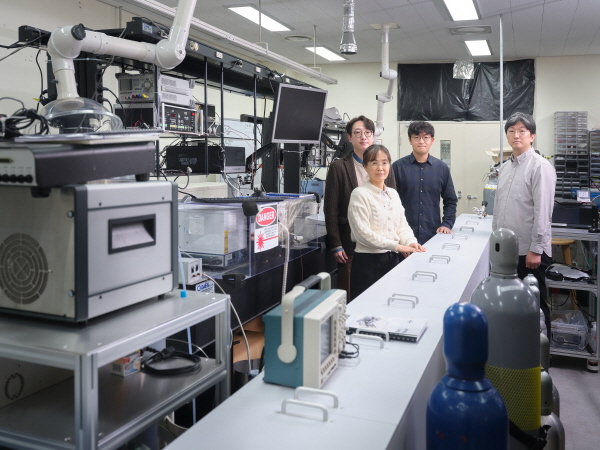산업현장에서 대량으로 사용되는 삼불화질소(NF3), 메탄(CF4), 육불화황(SF6) 등 온난화와 밀접한 가스들의 지구온난화지수(Global Warming Potential, GWP)를 정확히 측정할 수 있는 기술이 개발돼 저탄소 대체가스 개발에 기여할 것으로 기대가 모아진다.
▲KRISS 기후표준전략기술연구단(앞줄 좌측부터 시계방향으로 임정식 연구단장, 이정순 책임연구원, 한노수 선임연구원, 권도현 선임연구원)
정밀측정기술 개발, 대체가스 개발 기여 전망
산업현장에서 대량으로 사용되는 삼불화질소(NF3), 메탄(CF4), 육불화황(SF6) 등 온난화와 밀접한 가스들의 지구온난화지수(Global Warming Potential, GWP)를 정확히 측정할 수 있는 기술이 개발돼 저탄소 대체가스 개발에 기여할 것으로 기대가 모아진다.
한국표준과학연구원(KRISS, 원장 박현민)은 GWP 산출에 필요한 복사효율을 정확히 측정할 수 있는 고분해능 분자분광학 측정기술을 개발했다고 10일 밝혔다.
이번 기술 개발로 반도체 업계 등에서 활발히 연구 중인 친환경 대체가스의 지구온난화 영향에 대한 검증 기반을 제공할 것으로 기대된다.
그동안 GWP 산출에는 전 세계적으로 통용되는 측정절차가 미비했다. 유엔 산하 기후변화에 관한 정부간 협의체(IPCC)에서 평가 보고서를 통해 온실가스별 GWP 값을 제시하고 있지만, 회차별로 측정값이 상이하고 학계의 연구결과도 서로 달라 신뢰성이 부족했다.
KRISS 기후표준전략기술연구단이 이번에 개발한 고분해능 분자분광학 측정기술을 활용하면 최고 수준의 복사효율 측정신뢰성을 기대할 수 있다. 이번 성과로 한국은 전 세계적으로 통용되는 복사효율 측정절차를 제안했을 뿐 아니라 국가표준에 기반해 복사효율 측정절차를 마련한 유일한 국가가 됐다.
연구단은 복사효율의 정밀측정을 위해 기존 가스분석기 대비 500배 수준의 분해능을 갖춘 고분해능 분광기와 측정품질 유지기술을 적용했다.
이를 이용해 육불화황(SF6), 삼불화질소(NF3), 메탄(CF4) 등 반도체 공정에 사용되는 주요 온실가스들과 대체가스 후보물질들의 복사효율을 분석하고, IPCC가 제시한 GWP 값의 신뢰도를 높일 방안을 제시했다.
이번 성과는 특히 최근 산업계에서 활발히 논의되고 있는 저탄소배출 대체가스의 온실가스 감축 효과를 검증하는 데 활용될 전망이다. 정확한 GWP 평가를 기반으로 GWP가 낮은 대체가스를 개발해 현장에 적용하면 산업부문의 탄소배출을 대폭 줄일 수 있다.
임정식 기후표준전략기술연구단장은 “이번 성과는 전 세계적인 환경 규제가 심화되는 가운데 친환경 대체가스 개발에서 국내 산업계가 주도권을 확보할 초석이 될 것”이라며 ”향후 복사효율 측정표준을 더욱 강화하고 대기수명 측정표준을 추가로 확립해 GWP 측정의 신뢰도를 한층 끌어올리겠다”고 밝혔다.
KRISS는 미국, 영국, 중국 등 선진 표준연구기관은 물론 국제적 연구그룹과 협력해 대체가스 GWP 측정절차를 확립할 계획이다.
